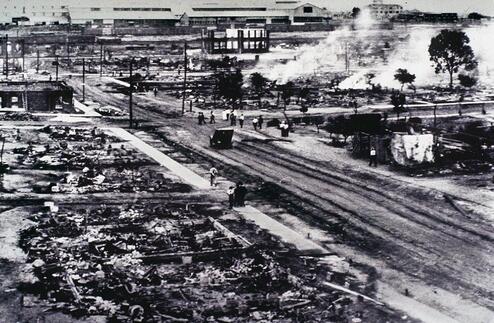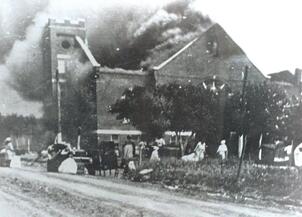“Truth Crushed to Earth Will Rise Again.”
William Cullen Bryant
--American Journalist and Poet
William Cullen Bryant
--American Journalist and Poet

“We must listen to one another and act with compassion. We are all different, we come from different places, backgrounds, families and identities; but by working together to embrace and value our differences, we create a stronger and better community. We look forward to bettering our future together.” – Greenwood Cultural Center
Tulsa, Oklahoma 1921: The Remarkable Story of the Resilient Community of "Greenwood"
In 1921, Tulsa, Oklahoma was home to one of the most prosperous African-American communities in the country. Businesses flourished along Greenwood Avenue -- dubbed the “Black Wall Street.” Residential neighborhoods spread out in a bustling community of several thousand. They built homes and businesses, schools and churches. Most of all, they built hope.
Then, in a little more than 12 hours, it was all gone: a riot that had begun at the Tulsa County Courthouse on the night of May 31, 1921, escalated into an all-out assault on the Greenwood community on the morning of June 1.
Tulsa became the site of one of the worst riots in American history. The catastrophe obliterated the prosperous Greenwood African-American community; In those hours, people, property, hopes, and dreams vanished. The damage ran into the millions. Scores, likely hundreds, of people died. Many others lay injured. Many African-Americans fled Tulsa, never to return. The city is, in some respects, still recovering.
Step 1: Hook (15 minutes)
“I came not to Tulsa as many came, lured by the dream of making money and bettering myself in the financial world, but because of the wonderful cooperation I observed among our people, and especially the harmony of spirit and action through hard work and wise investment that existed between men and women.”
Tulsa, Oklahoma 1921: The Remarkable Story of the Resilient Community of "Greenwood"
In 1921, Tulsa, Oklahoma was home to one of the most prosperous African-American communities in the country. Businesses flourished along Greenwood Avenue -- dubbed the “Black Wall Street.” Residential neighborhoods spread out in a bustling community of several thousand. They built homes and businesses, schools and churches. Most of all, they built hope.
Then, in a little more than 12 hours, it was all gone: a riot that had begun at the Tulsa County Courthouse on the night of May 31, 1921, escalated into an all-out assault on the Greenwood community on the morning of June 1.
Tulsa became the site of one of the worst riots in American history. The catastrophe obliterated the prosperous Greenwood African-American community; In those hours, people, property, hopes, and dreams vanished. The damage ran into the millions. Scores, likely hundreds, of people died. Many others lay injured. Many African-Americans fled Tulsa, never to return. The city is, in some respects, still recovering.
- The Greenwood community’s 10,000 residents live on the north side of the city. Where’s Tulsa in relationship to other parts of the United States? https://ontheworldmap.com/usa/city/tulsa/
- Here's a timeline of some important historical events of the Twentieth Century, https://bit.ly/3BSYMyH. Have your students locate “June 1, 1921” on the timeline for a general sense of historical context.
Step 1: Hook (15 minutes)
“I came not to Tulsa as many came, lured by the dream of making money and bettering myself in the financial world, but because of the wonderful cooperation I observed among our people, and especially the harmony of spirit and action through hard work and wise investment that existed between men and women.”

Have your students silently read the quote above, and ask each to call out the name of a family member – an aunt, an uncle, a parent or grandparent, or even someone close, like a neighbor – that the student admires for pursuing a dream, and why?
The exercise is easily completed by calling out famous names of historic figures; however, the exercise holds more power when students discover that the people they know, people who are close to them, are also capable of aspiring to extraordinary deeds.
The exercise is easily completed by calling out famous names of historic figures; however, the exercise holds more power when students discover that the people they know, people who are close to them, are also capable of aspiring to extraordinary deeds.
Step 2: Video Resources (20 minutes)
Step 3: Classroom Activity, Bringing Eyewitness Testimony to Life (20 minutes)
- Put this moving and elegiac music on as background in your class. The piece, “Pity These Ashes,” from the Greene Space in partnership with The Harlem Chamber Players, Harlem Stage and the Harlem School of the Arts, can be found at https://bit.ly/3dvt1DD (40 minutes)
- A 9-minute animation film covers the story of Tulsa 1921 at https://binged.it/3R5LmVo
- The History Channel lays out a general description of the era in the short video at https://binged.it/3xGehbE (7 minutes).
- Take inspiration from choreographer Alvin Ailey’s dance piece, "Greenwood." The 3-minute trailer from the Alvin Ailey American Dance Theater can be found at https://bit.ly/3xFJyvm. Have students use their social media tools to share.
- With the music and dance sources, you might ask students to brainstorm words to describe the mood evoked, and how it connects for them with the story of the Tulsa.
- If advanced students wish to go deeper into the meaning of “Tulsa 1921,” and how it relates to community healing and the way forward, Harvard University’s Carr Center for Human Rights Policy has hosted an in-depth discussion, “Looking Back, Looking Ahead,” at https://bit.ly/3qXwYE2 (one hour and fifteen minutes).
Step 3: Classroom Activity, Bringing Eyewitness Testimony to Life (20 minutes)

For too many years, the events of Tulsa were hushed over. This decades-long silence surrounding a tragic past left an air of suspicion and mistrust. The absence of dialogue, let alone, truth, tarnished black/white relations for generations. In more recent times, the last few survivors who were eyewitnesses to the events of 1921, began to share their stories.
This classroom activity involves having your students, each in turn, standing and reading aloud a short eyewitness paragraph. Assign several students to film the documentary “eyewitness stories,” with whichever light or sound effects they choose. Here are three testimonies to get started. More are available here, and through a simple online search.
Step 4: Next Steps, What Can Students Do?
"Peace cannot be kept by force, it can only be achieved by understanding." - Albert Einstein
This classroom activity involves having your students, each in turn, standing and reading aloud a short eyewitness paragraph. Assign several students to film the documentary “eyewitness stories,” with whichever light or sound effects they choose. Here are three testimonies to get started. More are available here, and through a simple online search.
- "There was a great shadow in the sky and upon a second look, we discerned that this cloud was caused by fast approaching airplanes. It then dawned upon us that the enemy had organized in the night and was invading our district the same as the Germans invaded France and Belgium."
- “After lining up some 30 or 40 of us men, they ran us through the streets to Convention Hall, forcing us to keep our hands in the air all the while. While we were running some of the ruffians would shoot at our heels and swore at those who had difficulty in keeping up. They actually drove a car into the bunch and knocked down two or three men.”
- “I saw my piano and all of my elegant furniture piled in the street. My wall safe had been broken open, all of the money stolen, also my silverware, cut glass, all of the family clothing, and everything of value had been removed, even my family Bible.”
- Follow-up by having the class watch highlights from the moving Congressional testimony at https://cbsn.ws/3f2qpxj (2 minutes).
- Classroom Discussion: Why did this story go unknown for so many years? A 1999 CBS “60 Minutes” report shed light on how the story remained untold for generations, https://bit.ly/3BUc3qP, (14 minutes). You might also ask students to identify an episode in the life of their community that they would want to be sure was not forgotten or ignored.
Step 4: Next Steps, What Can Students Do?
"Peace cannot be kept by force, it can only be achieved by understanding." - Albert Einstein
- Your students and your school can join “Team Harmony” at http://www.TeamHarmonyInstitute.org. Founded in 1994, Team Harmony is a nationally recognized multicultural forum designed to unite youth of all backgrounds in the battle against prejudice, bigotry and hatred. Contact Team Harmony to learn more about their social justice programs to educate, engage, and teach tolerance, particularly around the events surrounding “Tulsa 1921.”
- Recall Angela Davis: "Walls turned sideways are bridges." You and your class can do something in the face of hatred and show the community that apathy will not win. Start here with downloading “Ten Ways to Fight Hate: A Community Response Guide,” https://bit.ly/3UudO6b, provided by the Southern Poverty Law Center, and explore their creative suggestions to support democracy through teaching tolerance.

Activities to engage students in studying and writing about historical topics, https://bit.ly/3UQDHNI
AFT Resources
- AFT’s Share My Lesson: Resources and lesson plans done by teachers, for teachers, “Tulsa Massacre’s Effects on Black Community 100 Years Later,” https://bit.ly/3DZFMBl
- “Lesson Plan for the 1921 Tulsa Race Massacre,” from AFT partner “C-Span Classroom,” https://bit.ly/3BVRewf
- AFT’s resources at Colorín Colorado: “Talking with Children About Tragedy in the News,” https://bit.ly/3duKsUK

“Only by owning our history do we stand a chance of real reconciliation. It will require committed, intentional, and constructive engagement.” – American Historian and Tulsa Native, John Hope Franklin
- Greenwood Cultural Center: “The Center serves as a marker for the Tulsa community, chronicling where we have been, where we are, and where we are going,” teacher resources at https://bit.ly/3M2mCwg
- The John Hope Franklin Center for Reconciliation in Tulsa has initiated a number of community-engagement reconciliatory projects, exploring the historical memory in multiple generations of families, black and white, at https://bit.ly/3C0WgYu
- Greenwood Rising Museum: “Let us honor the memory of those who lost their lives and the survivors,” https://bit.ly/3LwRxk6
- Video: “Talking About Race, Love and Truth: For Caregivers and Teachers,” https://bit.ly/3BC7hxV, (Library of Congress, 30 minutes)
- Video: “Talking About Race, Love and Truth: For Kids and Teens,” https://bit.ly/3R7Jag1, (Library of Congress, 40 minutes)
- Teaching strategies and student-friendly resources from “Learning for Justice,” https://bit.ly/3BuoSYu
- Online historical collection and everyday cultural artifacts from “Tulsa 1921” at the National Museum of African American History and Culture, “Tulsa Objects in the NMAAHC Collection,” https://s.si.edu/3SaqXjC

